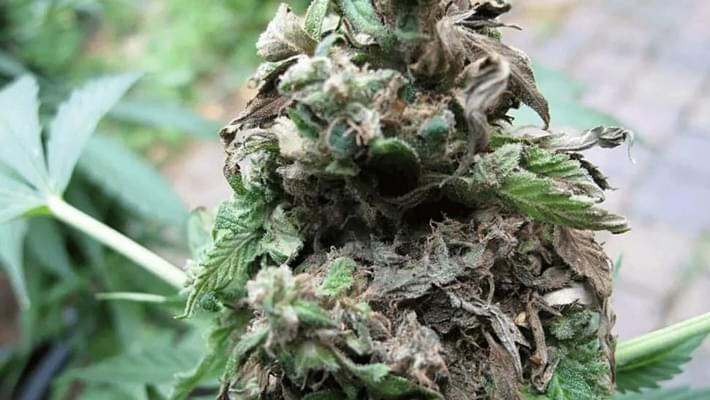
Growing 101: How to Prevent & Fix Bud Rot
Published on 11/26/22
Growing cannabis isn't an easy task, whether you do so professionally or as a hobby at home. That doesn't mean it isn't a very worthwhile pursuit! If you know how to grow weed, you also know how sweet the fruits of that labor can be. There are a lot of obstacles to overcome between planting a seed and harvesting that beautiful bud, one of which is bud rot weed. Let's take a look at some tell-tale bud rot signs, ways of salvaging bud rot, and potential bud rot cure options.
What Is Bud Rot?
While it's commonly known throughout the cannabis industry as "bud rot," it's formerly known as Botrytis, a type of gray mold that affects a wide variety of plants and vegetables, including cannabis.
One of the first questions you probably have is, "what does bud rot look like specifically?" Good question. Here are some of the primary symptoms of bud rot:
- Yellow, brow, wilted leaves
- Gray coloration of stems
- Fluffy, white fungus on the buds
- Dark, purple coloration of the leaves
- Small black spots
- Rotten, brown buds
- Other visible signs of mold
The first symptom will likely be a mushy, grayish coloration of the stems as the bud rot takes root. It will then likely move into the leaves, causing that yellowish, brownish wilting, decayed look. Then, in its final stages, it'll set into the bud itself and cause rotting and aggressive mold growth. If your cannabis starts to get moldy while still growing, there's a strong chance that bud rot has already set into the plant.
What Causes Bud Rot?
Bud rot has similar causes to other types of mold, all of which are dangerous if consumed. The most frequent causes of bud rot include high humidity levels, stagnant air (caused by inadequate HVAC systems), or mild temperatures. It's also worth noting that plants with higher density and/or larger buds are at a higher risk of getting bud rot because moisture collects much quicker when there's less room for heat and humidity to breathe. Additionally, because moisture is such a significant factor, growers in coastal regions should be especially aware of humidity and built-up moisture in their plants (both inside and outside).
Preventing Bud Rot Outdoors and Indoors
There are a few tips and tricks well known for preventing bud rot weed. Bud rot can develop indoors and outdoors, and it can produce spores that quickly spread to other plants in the surrounding area, regardless of whether it's in a grow room or field. Of course, how you combat this pesky rot is slightly different depending on where you grow. Here are some of the main things to keep in mind as you look to prevent bud rot.
Avoid Humidity
Proper humidity can be controlled in indoor spaces, like temperature, with a thermostat and dehumidifiers. If you're growing plants outdoors, try to create a temporary cover for your plants when it rains so that moisture doesn't get trapped in the leaves.
Keep Air Circulating
This isn't so much of an issue for outdoor growing. If you're growing indoors, this can be easily fixed by installing fans, having an up-to-date AC system, and opening windows for further circulation.
Defoliate Overgrown Plants
As we mentioned above, when plants get too bushy and overgrown, moisture gets trapped inside, and the plant can develop mold before you ever get a chance to see it. To combat this, regularly trim the leaves and most overgrown parts of the plant. To this effect, it's also good practice to keep your plants evenly distanced from each other with enough room to healthily breath and grow.
Watch for Discoloration
The most obvious of our solutions, but very effective: keep an eye on your plants regularly. Because the first signs of bud rot will likely come from discoloration and slight decay in the stems and leaves, we highly recommend keeping an eye on the color of your stems and leaves daily.
Bud Rot Fixes and Cures
The best way to fix bud rot is to avoid it altogether. Because of this, we highly recommend you take a look at the tips listed above for preventing bud rot. If your plants have already developed bud rot, though, here are a few things we recommend you do to avoid further issues or contamination.
Remove All Affected Parts of a Plant Immediately
Remove all rotted parts of a plant as soon as you identify bud rot. There is no way to get rid of bud rot once it's hit part of a plant, but you can save the rest of the plant if you act quickly. As you're removing the rot, make sure it doesn't touch any healthy parts of the plant; that contact might be enough to cause spread and further damage.
Quarantine Affected Plants
Once you have removed all affected parts of a plant, remove those plants from the rest of your plants so that any accidental remaining rot will not spread. When removed, put your plants in a cool, dry, and breezy spot to guarantee conditions won't benefit bud rot.
Fix the Environment or Harvest Early
Even if you successfully remove all affected plants and stop the rot from spreading, you still have to consider what caused the bud rot in the first place. It's likely something to do with your environment (whether that's humidity, air circulation, overgrown plants, etc.). If you can't fix the environmental issue at the root of the issue, we highly recommend harvesting your other plants early before they also develop bud rot.
Final Note
Do not use any fungicides, including Neem oil or sulfur. These tactics will ruin the flavor and burn of your final cannabis product.
Have you had to deal with bud rot before? Let us know what methods you've used to prevent or cure it. Comment below!
